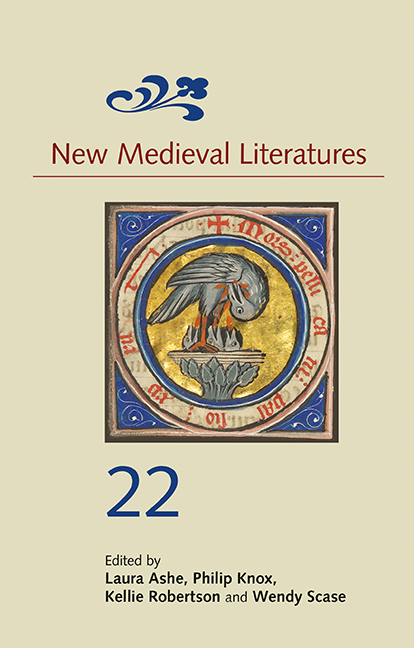Book contents
- Frontmatter
- Contents
- List of Illustrations
- List of Abbreviations
- 1 Touch and Movement in Chrétien de Troyes’s Chevalier de la Charrette
- 2 Cavernous Charisma: The Caves of the Patriarchs at Hebron
- 3 Lawman’s Vision of History: Sources and Figuration in the Brut
- 4 What the Mole Knows: Experience, Exempla, and Interspecies Dialogue in Albert the Great’s De animalibus
- 5 Demonic Prosthesis and the Walking Dead: The Materiality of Chaucer’s Green Yeoman
- 6 Learning to Live in Communities: Household Confession and Medieval Forms of Living
- 7 Alain Chartier’s Quadrilogue invectif and the Poetics of Political Community
- 8 Reginald Pecock’s moral philosophie, and Robert Holcot O.P.: Faith, Probabilism, and ‘Conscience’
- New Medieval Literatures Scholars of Colour Essay Prize
3 - Lawman’s Vision of History: Sources and Figuration in the Brut
Published online by Cambridge University Press: 26 May 2022
- Frontmatter
- Contents
- List of Illustrations
- List of Abbreviations
- 1 Touch and Movement in Chrétien de Troyes’s Chevalier de la Charrette
- 2 Cavernous Charisma: The Caves of the Patriarchs at Hebron
- 3 Lawman’s Vision of History: Sources and Figuration in the Brut
- 4 What the Mole Knows: Experience, Exempla, and Interspecies Dialogue in Albert the Great’s De animalibus
- 5 Demonic Prosthesis and the Walking Dead: The Materiality of Chaucer’s Green Yeoman
- 6 Learning to Live in Communities: Household Confession and Medieval Forms of Living
- 7 Alain Chartier’s Quadrilogue invectif and the Poetics of Political Community
- 8 Reginald Pecock’s moral philosophie, and Robert Holcot O.P.: Faith, Probabilism, and ‘Conscience’
- New Medieval Literatures Scholars of Colour Essay Prize
Summary
Lawman's additions to Wace separate his version of the Brut from the rest of the tradition stemming from Geoffrey of Monmouth's Historia Regum Brittaniae (c.1138). Lawman composed the first Middle English Brut in the early thirteenth century, likely between 1199 and 1227. He positions himself in an agonistic relationship to his source text, Wace's French Roman de Brut (1155), even as he translates most of it relatively faithfully. While Wace presents a resolutely secular account that moves ‘from king to king and heir to heir’, Lawman instead affiliates his poem with Latin monastic historiography of England. In his well-known prologue, Lawman places himself in the company of monastic historians who used a robust array of sources to glimpse God's disposition of events. He draws on Bede and Augustine as he reinvents the episodic history he found in his source. In his view, Wace's Brut failed to reflect the disjunction between human experiences of time and the divine disposition of history. For the Middle English poet, history is comprised of distinguishable but related temporalities. In Lawman's revised history, cyclical divine time thrums in the background of the human experience of linear subjective time. Put simply, Lawman's additions to Wace's text reflect the methods and philosophy of history more often associated with monastic writing.
Despite the suggestive portrait of a Benedictine monk in the historiated initial that begins one copy of Lawman's Brut (fig. 3.1), this claim is not necessarily meant to be biographical. Secular historians writing around Lawman's time, such as Henry of Huntingdon, similarly adopted methods and perspectives inherited from Bede. Rather, I mean only to name a significant difference between Lawman's Brut and other Bruts, and identify a strategy Lawman used both to demonstrate his understanding of the workings of history and to garner authority for his early Middle English text.
Two Manuscripts, Equal Authority
Studying Lawman's Brut poses a thorny methodological problem. Since the 1960s, manuscript scholars have concurred that the two surviving manuscripts containing Lawman's Brut, London, British Library, MS Cotton Caligula A.ix (hereafter Caligula) and London, British Library, MS Cotton Otho C.xiii (Otho), are roughly contemporaneous. Caligula dates from the second half of the thirteenth century, and Otho from the final third of the same.
- Type
- Chapter
- Information
- New Medieval Literatures 22 , pp. 55 - 90Publisher: Boydell & BrewerPrint publication year: 2022



